Aigis D5CH211W-W Handleiding
Aigis
Bewakingscamera
D5CH211W-W
Bekijk gratis de handleiding van Aigis D5CH211W-W (12 pagina’s), behorend tot de categorie Bewakingscamera. Deze gids werd als nuttig beoordeeld door 53 mensen en kreeg gemiddeld 5.0 sterren uit 27 reviews. Heb je een vraag over Aigis D5CH211W-W of wil je andere gebruikers van dit product iets vragen? Stel een vraag
Pagina 1/12

d out
2 Con
Tighte
I O IN S T A L L A T I O N A N D P E R A T I N G N S T R U C T I O N S
WWW. .A I G I S M E C H C O M
5-INCH
INTEGRATED OMED PACKAGE S( )
D5 SERIES
Pendant Pole
Pendant Wall
In-Ceiling Recess

2
IMPORTANT SAFEGUARDS
1. Read Instructions - All the safety and operating
instructions should be read before the unit is operated.
2. Retain Instructions - The safety and operating
instructions should be retained for future reference.
3. Heed Warnings - All warnings on the unit and in the operating
instructions should be adhered to.
4. Follow Instructions - All operating and use instructions should be
followed.
5. Cleaning - Unplug the unit from the outlet before cleaning. Do not use
liquid cleaners or aerosol cleaners. Use a damp cloth for cleaning.
6. Attachments - Do not use attachments not recommended by the
product manufacturer as they may cause hazards.
7. Water and Moisture - Do not use this unit near water - for example,
in a wet basement, near a swimming pool, in an unprotected outdoor
installation, or in any area which is classified as a wet location.
8. Accessories - Do not place this unit on an unstable stand, tripod,
bracket, or mount. The unit may fall, causing serious injury to a person
and serious damage to the unit. Use only with a stand, tripod, bracket,
or mount recommended by the manufacturer or sold with the product.
Any mounting of the unit should follow the manufacturer’s instructions
and should use a mounting accessory recommended by the
manufacturer.
An appliance and cart combination should be moved with care.
Quick stops, excessive force, and uneven surfaces may cause the
appliance and cart combination to overturn.
9. Ventilation - Openings in the enclosure, if any, are provided for
ventilation, to ensure reliable operation of the unit, and to protect it
from overheating. These openings must not be blocked or covered.
This unit should not be placed in a built-in installation unless proper
ventilation is provided or the manufacturer’s instructions have been
adhered to.
10. Power Sources - This unit should be operated only from the type of
power source indicated on the marking label. If you are not sure of the
type of power supply you plan to use, consult your dealer or local
power company. For units intended to operate from battery power or
other sources, refer to the operating instructions. This equipment is to
be isolated from the mains supply by a limited power source as specified
in EN60950:1992 Clause 2.11.
11. Grounding or Polarization - This unit may be equipped with a polarized
alternating-current line plug (a plug having one blade wider than the
other). This plug will fit into the power outlet only one way. This is a
safety feature. If you are unable to insert the plug fully into the outlet,
try reversing the plug. If the plug should still fail to fit, contact your
electrician to replace your obsolete outlet. Do not defeat the safety
purpose of the polarized plug.
Alternately, this unit may be equipped with a 3-wire grounding-type
plug, a plug having a third (grounding) pin. This plug will only fit into a
grounding-type power outlet. This is a safety feature. If you are unable
to insert the plug into the outlet, contact your electrician to replace
your obsolete outlet. Do not defeat the safety purpose of the
grounding-type plug.
12. Power Cord Protection - Power supply cords should be routed so that
they are not likely to be walked on or pinched by items placed upon or
against them, paying particular attention to cords and plugs,
convenience receptacles, and the point where they exit from the
appliance.
13. Power Lines - An outdoor system should not be located in the vicinity
of overhead power lines or other electric light or power circuits or
where it can fall into such power lines or circuits. When installing an
outdoor system, extreme care should be taken to keep from touching
such power lines or circuits as contact with them might be fatal.
U.S.A. models only - refer to the National Electrical Code Article 820
regarding installation of CATV systems.
14. Overloading - Do not overload outlets and extension cords as this can
result in a risk of fire or electric shock.
15. Object and Liquid Entry - Never push objects of any kind into this unit
through openings, as they may touch dangerous voltage points or short
out parts that could result in a fire or electric shock. Never spill liquid
of any kind on the unit.
Warning
This is A class A product. In a domestic environ-
ment, this product may cause radio interference in
which case the user may Be required To take ade-
quate measures.
16. Servicing - Do not attempt to service this unit yourself as opening or
removing covers may expose you to dangerous voltage or other
hazards. Refer all servicing to qualified service personnel.
17. Damage Requiring Service - Unplug the unit from the outlet and refer
servicing to qualified service personnel under the following conditions:
a. When the power supply cord or plug is damaged.
b. If liquid has been spilled or objects have fallen into the unit.
c. If the unit has been exposed to water and/or inclement weather (rain,
snow, etc.).
d. If the unit does not operate normally by following the operating
instructions. Adjust only those controls that are covered by the
operating instructions, as an improper adjustment of other controls
may result in damage and will often require extensive work by a
qualified technician to restore the unit to its normal operation.
e. If the unit has been dropped or the cabinet has been damaged.
f. When the unit exhibits a distinct change in performance—this indicates
a need for service.
18. Replacement Parts - When replacement parts are required, be sure the
service technician has used replacement parts specified by the
manufacturer or have the same characteristics as the original part.
Unauthorized substitutions may result in fire, electric shock, or other
hazards.
19. Safety Check - Upon completion of any service or repairs to this unit,
ask the service technician to perform safety checks to determine that
the unit is in proper operating condition.
20. Coax Grounding - If an outside cable system is connected to the unit,
be sure the cable system is grounded. U.S.A. models only—Section 810
of the National Electrical Code, ANSI/NFPA No.70-1981, provides
information with respect to proper grounding of the mount and
supporting structure, grounding of the coax to a discharge unit, size of
grounding conductors, location of discharge unit, connection to
grounding electrodes, and requirements for the grounding electrode.
21. Lightning - For added protection of this unit during a lightning storm,
or when it is left unattended and unused for long periods of time,
unplug it from the wall outlet and disconnect the cable system. This
will prevent damage to the unit due to lightning and power-line surges.
FCC & ICES INFORMATION
(U.S.A. and Canadian Models Only)
WARNING - This equipment has been tested and found to comply with the
limits for a Class A digital device, pursuant to Part 15 of the FCC Rules
and ICES-003 of Industry Canada. These limits are designed to provide
reasonable protection against harmful interference when the equipment
is operated in a commercial environment. This equipment generates,
uses, and radiates radio frequency energy and, if not installed and used
in accordance with the instruction manual, may cause harmful
interference to radio communications. Operation of this equipment in
a residential area is likely to cause harmful interference in which case
the user will be required to correct the interference at his own
expense. Intentional or unintentional changes or modifications not
expressly approved by the party responsible for compliance shall not
be made. Any such changes or modifications could void the user’s
authority to operate the equipment.
If necessary, the user should consult the dealer or an experienced
radio/television technician for corrective action. The user may find the
following booklet prepared by the Federal Communications
Commission helpful: “How to Identify and Resolve Radio-TV
Interference Problems.” This booklet is available from the U.S.
Government Printing Office, Washington, DC 20402, Stock
No.004-000-00345-4.

SECURITE
3
Appareils 24 VCA: Ne pas excéder 30 VCA. La tension
appliquée à l'entrée d'alimentation de l'appareil ne devrait pas
excéder 30 VCA. Toute installation électrique fournissant du
24 Volts courant alternatif doit être conforme aux codes
électriques. (Niveaux d'alimentation de la Classe 2). Ne pas
brancher une prise de terre sur les bornes d'alimentation 24
Volts ou aux bornes d'alimentation de l'appareil.
24 VAC Units: Do Not Exceed 30 VAC Input. Voltage
applied to the unit’s power input should not exceed 30 VAC.
Normal input voltage is 24 VAC. User supplied wiring from 24
VAC supply to unit must be in compliance with electrical
codes (Class 2 power levels). Do not ground 24 VAC supply
at power supply terminals or at unit’s power supply terminals.
This equipment is to be isolated from the mains
supply by a limited power source as specified in
EN60950:1992 Clause 2.11.
En raison de limitation de place, cette étiquette peut être
placée sur le dessous de l'appareil.
L'éclair fléché dans un triangle équilatéral, avertit l'u-
tilisateur de la présence d'une “tension dangereuse”
non isolée à l'intérieur de l'appareil et d'une valeur
suffisante pour constituer un risque d'électrocution.
Le point d'exclamation contenu dans un triangle
équilatéral, avertit l'utilisateur de la présence, dans
la documentation qui accompagne l'appareil, de con-
signes d'utilisation et de maintenance importantes
.
Attention: L'installation doit être effectuée unique-
ment par du personnel de service qualifié conformé-
ment à la réglementation du Code Electrique
National ou à la réglementation locale.
This label may appear on the bottom of the unit due to space
limitations.
The lightning flash with an arrowhead symbol within
an equilateral triangle is intended to alert the user
to the presence of uninsulated “dangerous voltage”
within the product's enclosure that may be of suffi-
cient magnitude to constitute a risk of electric
shock to persons.
The exclamation point within an equilateral triangle
is intended to alert the user to presence of impor-
tant operating and maintenance (servicing) instruc-
tions in the literature accompanying the appliance.
Attention: Installation should be performed by quali-
fied service personnel only in accordance with the
National Electrical Code or applicable local codes.
CAUTION: TO REDUCE THE RISK OF ELECTRI-
CAL SHOCK, DO NOT OPEN COVERS. NO USER
SERVICEABLE PARTS INSIDE. REFER SERVICING
TO QUALIFIED SERVICE PERSONNEL.
Warning
To prevent fire or shock hazard, do not expose units
to rain or moisture.
Danger: Pour éviter tout risque d’électrocution, ne pas
ouvrir le boîtier. Il n’y a pas de pièces remplaçables à l’in-
térieur. Pour toute révision, s’adresser à un technicien spé-
cialisé.
Attention:
Pour éviter le risque d'électrocution ou d'incendie, ne
pas exposer à la pluie ou à l'humidité un appareil.
SECURITY
Product specificaties
| Merk: | Aigis |
| Categorie: | Bewakingscamera |
| Model: | D5CH211W-W |
Heb je hulp nodig?
Als je hulp nodig hebt met Aigis D5CH211W-W stel dan hieronder een vraag en andere gebruikers zullen je antwoorden
Handleiding Bewakingscamera Aigis

7 Juli 2023

6 Juli 2023

6 Juli 2023

5 Juli 2023

5 Juli 2023

5 Juli 2023

4 Juli 2023

4 Juli 2023

3 Juli 2023

2 Juli 2023
Handleiding Bewakingscamera
Nieuwste handleidingen voor Bewakingscamera
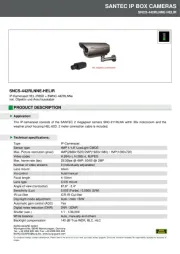
3 Augustus 2025
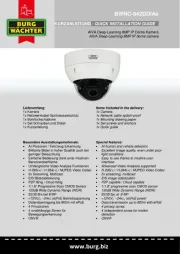
3 Augustus 2025
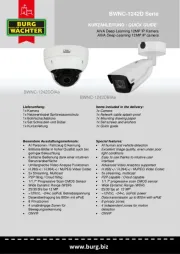
3 Augustus 2025
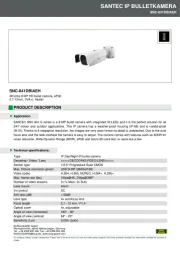
2 Augustus 2025
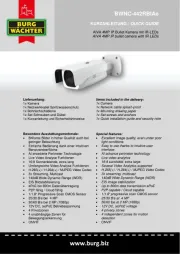
2 Augustus 2025
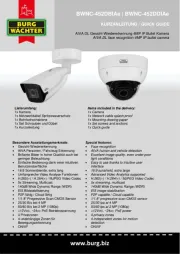
2 Augustus 2025
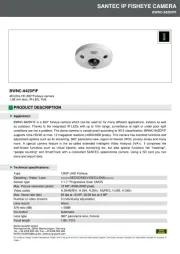
2 Augustus 2025
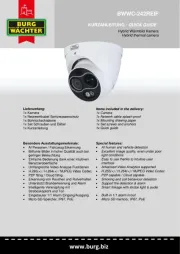
2 Augustus 2025
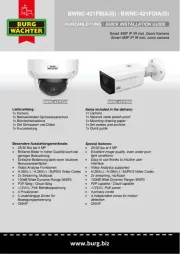
2 Augustus 2025
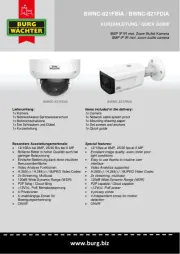
2 Augustus 2025